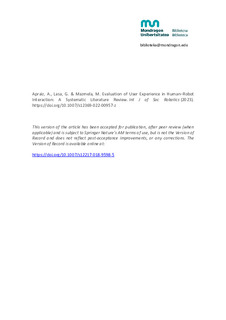Izenburua
Evaluation of User Experience in Human–Robot Interaction : A Systematic Literature ReviewBertsioa
Postprinta
Eskubideak
© 2023 SpringerSarbidea
Sarbide irekiaArgitaratzailearen bertsioa
https://doi.org/10.1007/s12369-022-00957-zNon argitaratua
International Journal of Social Robotics Argitaratzailea
SpringerGako-hitzak
Human–robot collaboration
human machine interaction
human-computer interaction
Human Robot Interaction ... [+]
human machine interaction
human-computer interaction
Human Robot Interaction ... [+]
Human–robot collaboration
human machine interaction
human-computer interaction
Human Robot Interaction
user experience
Systematic literature reviews
Human Factors [-]
human machine interaction
human-computer interaction
Human Robot Interaction
user experience
Systematic literature reviews
Human Factors [-]
Laburpena
Industry 4.0 has ushered in a new era of process automation, thus redefining the role of people and altering existing workplaces into unknown formats. The number of robots in the manufacturing industr ... [+]
Industry 4.0 has ushered in a new era of process automation, thus redefining the role of people and altering existing workplaces into unknown formats. The number of robots in the manufacturing industry has been steadily increasing for several decades and in recent years the number and variety of industries using robots have also increased. For robots to become allies in the day-to-day lives of operators, they need to provide positive and fit-for-purpose experiences through smooth and satisfying interactions. In this sense, user experience (UX) serves as the greatest link between persons and robots. Essential to the study of UX is its evaluation. Therefore, the aim of this study is to identify methodologies that evaluate the human–robot interaction (HRI) from a human-centred approach. A systematic literature review has been carried out, in which 24 articles have been identified. Among these, are 15 experimental studies, in addition to theoretical frameworks and tools. The review has provided insight into how evaluations are conducted in HRI. The results show the most evaluated factors and how they are measured considering different types of measurements: qualitative and quantitative, objective and subjective. Research gaps and future directions are correspondingly identified. [-]
Bildumak
Related items
Showing items related by title, author, creator and subject.
-
NBEko giza eskubideei buruzko ikerketa zentroko lehendakariak bakeari eta giza eskubideei buruz hitz egingo du Mondragon Unibertsitatean
Mondragon Unibertsitatea (Mondragon Unibertsitatea, 2014-03-04)Kyun-seo giza eskubideen defendatzaile ospetsua da nazioartean. Hori dela eta, unibertsitateak gonbidapena luzatu dio, bere ikuspegia eman dezan XXI. mendeko biztanleek aurretik dituzten erronken inguruan: bakearen mezulari ... -
Development and validation of Human-Robot Experience (HUROX) questionnaire for industrial collaborative contexts
Apraiz Iriarte, Ainhoa; Lasa, Ganix; Mazmela Etxabe, Maitane; Escallada Lopez, Oscar; Gonzalez-de-Heredia, Arantxa (AEIPRO, 2023)An increasing number of robots are being implemented in Industry 5.0, which aims to put the well-being of the operators at the centre. From a human-centred design perspective, it is crucial to assess the perception and ... -
Transdisciplinary humanities for social transformation: The Global Digital Humanities degree at Mondragon University AS Fabrik
Zuberogoitia, Aitor; Madinabeitia, Monika (Berghahn Journals, 2024-03-01)The new degree in the Global Digital Humanities has been launched by the Faculty of Humanities and Education at Mondragon University on its new urban campus of Bilbao AS Fabrik. In a time of increas- ing urbanisation, ...





















